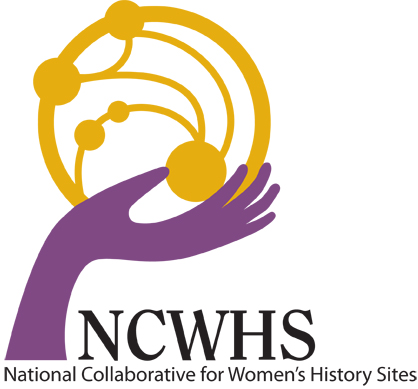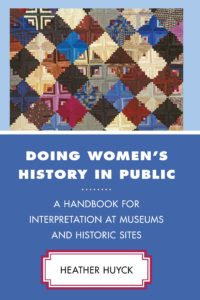This is the inaugural blog post from the Research & Interpretation Committee of the National Collaborative for Women’s History Sites (NCWHS). Our Committee has had many a robust conversation about the needs such an endeavor can meet. We know that blogs can tell incredible stories, explaining what is known about a topic and speculating over what else we need to know. We discussed how a blog writer should strive to spark dialogue with the readers, generating comments and questions as an opportunity to uplift values, appreciate worthy individuals, and to amplify valiant voices.
Amplifying voices, in particular women’s voices, is a driving value of the NCHWS, which was created in 2001 by representatives of more than forty historical sites linked to American women and/or preserving women’s history. “America’s story makes no sense with half of its participants missing,” argues Dr. Heather Huyck, a member of the founding steering committee and an Organization of American Historians (OAH) Distinguished Lecturer. “Leaving women out of the story is as serious a distortion of our history as trying to tell the history of the Civil War without talking about black history.”
Our committee believes you will find this to be an invaluable resource, just as our forthcoming “Toolkit of Women’s History” will also be for those of you amplifying the voices of women within public history. Dr. Huyck as a historian, educator, and author has been a decades-long advocate for women’s history, and our Committee thought it appropriate to launch this blog by featuring her new publication, Doing Women’s History in Public: A Handbook for Interpretation at Museums and Historic Sites (Rowman & Littlefield, 2020).
We would love to hear from you! Does your historic site include women’s history and if so, how did your site first implement that interpretation? How have visitors responded to these programs and exhibits? And, what advice would you have for sites that are just beginning to include the interpretation of women and girls? If your site has not included women and girls, what tools and resources do you need to amplify their stories?
Doing Women’s History in Public: A Handbook for Interpretation at Museums and Historic Sites by Heather Huyck
Review by RIC Committee Member Janice Sumler-Edmond
A promise made and a promise fulfilled describes the exciting new book by historian Heather Huyck. With her focus on the field of Public Women’s History, found primarily at museums and historic sites, Huyck bridges a divide often separating the academic historian and the public historian in their work and ideology. The book reveals that articulating historical interpretation and purpose are essential to the work product of both groups. The author reminds us of the numerous accomplishments in the field of Public Women’s History, and points out many creative pathways to guide our way forward.
Huyck’s book is a step-by-step guide to pursuing Public Women’s History. Commencing with the significance of this field of history, she shows how our desire to save what is important translates into preserving a legacy for future generations. The author reminds us that the historian’s work is to identify spaces and objects of the past, preserve them, and provide context and meaning through our analytical and interpretative skills. Huyck explains that museums and historic sites, like suffragist Elizabeth Cady Stanton’s house in Seneca Falls, “provide space, experiences, insights, and tangible objects that encourage people to learn about their own past and our nation’s history.” Similarly, the historian must also uncover evidence of women’s activity in both usual and unusual spaces. Huyck included a photo of a nineteenth-century lunch bucket used by male miners. Such objects became a part of a woman’s daily work when miners’ wives or “bucket girls” filled the buckets with either meat and potatoes or tortillas and beans, depending on the man’s ethnicity. Another striking image in the book shows a crowded banquet room in 1920 with about 200 Masons, seated and waiting for their meal. Also seen in the photo are two women, partially obscured from view and standing near the kitchen door, preparing to serve the men.
Throughout her book, Huyck discusses many of the research tools available to the historian in the field of Public Women’s History. Creativity and imagination are the engines that fuel the historian’s work, whether the historical displays will be housed in a museum or on a battlefield. According to Huyck, oral sources, including interviews and recordings, as well as physical items like jewelry or furniture allow us to reveal important aspects of women’s lives. Locations such as fields and gardens or structures, including buildings and houses, also serve as evidence for our research and history telling. Huyck’s new book, which also includes case studies, photographs and a great bibliography, delightfully invites and informs historians to employ their skills of analysis and interpretation, thereby revealing many truths about women’s lives and women’s history.
To purchase Dr. Huyck’s book, Doing Women’s History in Public: A Handbook for Interpretation at Museums and Historic Sites visit:

